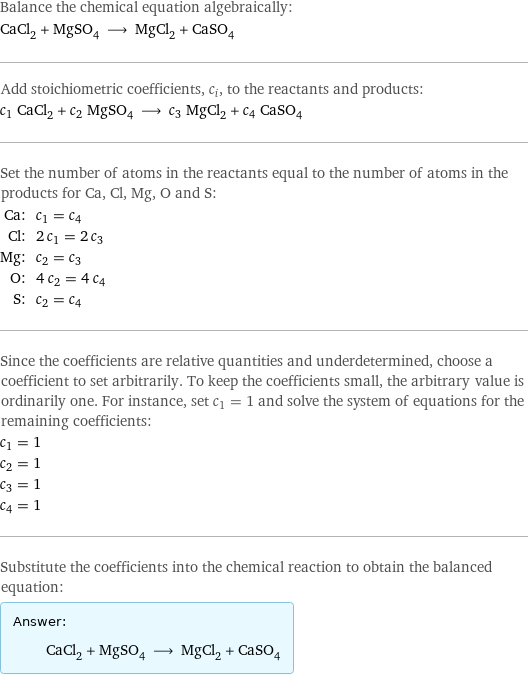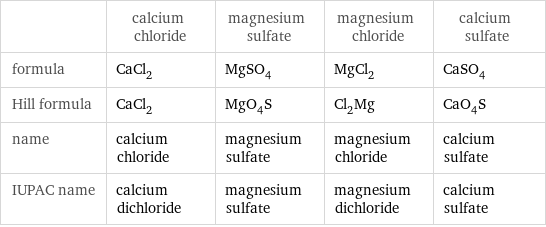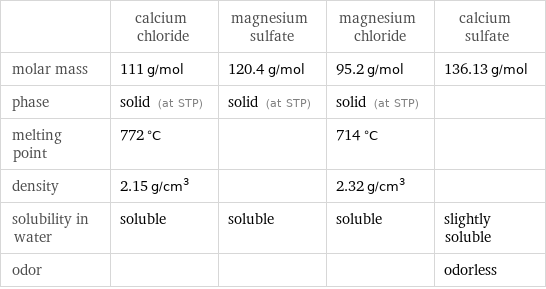Input interpretation

CaCl_2 calcium chloride + MgSO_4 magnesium sulfate ⟶ MgCl_2 magnesium chloride + CaSO_4 calcium sulfate
Balanced equation

Balance the chemical equation algebraically: CaCl_2 + MgSO_4 ⟶ MgCl_2 + CaSO_4 Add stoichiometric coefficients, c_i, to the reactants and products: c_1 CaCl_2 + c_2 MgSO_4 ⟶ c_3 MgCl_2 + c_4 CaSO_4 Set the number of atoms in the reactants equal to the number of atoms in the products for Ca, Cl, Mg, O and S: Ca: | c_1 = c_4 Cl: | 2 c_1 = 2 c_3 Mg: | c_2 = c_3 O: | 4 c_2 = 4 c_4 S: | c_2 = c_4 Since the coefficients are relative quantities and underdetermined, choose a coefficient to set arbitrarily. To keep the coefficients small, the arbitrary value is ordinarily one. For instance, set c_1 = 1 and solve the system of equations for the remaining coefficients: c_1 = 1 c_2 = 1 c_3 = 1 c_4 = 1 Substitute the coefficients into the chemical reaction to obtain the balanced equation: Answer: | | CaCl_2 + MgSO_4 ⟶ MgCl_2 + CaSO_4
Structures

+ ⟶ +
Names

calcium chloride + magnesium sulfate ⟶ magnesium chloride + calcium sulfate
Equilibrium constant
![Construct the equilibrium constant, K, expression for: CaCl_2 + MgSO_4 ⟶ MgCl_2 + CaSO_4 Plan: • Balance the chemical equation. • Determine the stoichiometric numbers. • Assemble the activity expression for each chemical species. • Use the activity expressions to build the equilibrium constant expression. Write the balanced chemical equation: CaCl_2 + MgSO_4 ⟶ MgCl_2 + CaSO_4 Assign stoichiometric numbers, ν_i, using the stoichiometric coefficients, c_i, from the balanced chemical equation in the following manner: ν_i = -c_i for reactants and ν_i = c_i for products: chemical species | c_i | ν_i CaCl_2 | 1 | -1 MgSO_4 | 1 | -1 MgCl_2 | 1 | 1 CaSO_4 | 1 | 1 Assemble the activity expressions accounting for the state of matter and ν_i: chemical species | c_i | ν_i | activity expression CaCl_2 | 1 | -1 | ([CaCl2])^(-1) MgSO_4 | 1 | -1 | ([MgSO4])^(-1) MgCl_2 | 1 | 1 | [MgCl2] CaSO_4 | 1 | 1 | [CaSO4] The equilibrium constant symbol in the concentration basis is: K_c Mulitply the activity expressions to arrive at the K_c expression: Answer: | | K_c = ([CaCl2])^(-1) ([MgSO4])^(-1) [MgCl2] [CaSO4] = ([MgCl2] [CaSO4])/([CaCl2] [MgSO4])](../image_source/03730923d5fac7c97187c73f1c32d135.png)
Construct the equilibrium constant, K, expression for: CaCl_2 + MgSO_4 ⟶ MgCl_2 + CaSO_4 Plan: • Balance the chemical equation. • Determine the stoichiometric numbers. • Assemble the activity expression for each chemical species. • Use the activity expressions to build the equilibrium constant expression. Write the balanced chemical equation: CaCl_2 + MgSO_4 ⟶ MgCl_2 + CaSO_4 Assign stoichiometric numbers, ν_i, using the stoichiometric coefficients, c_i, from the balanced chemical equation in the following manner: ν_i = -c_i for reactants and ν_i = c_i for products: chemical species | c_i | ν_i CaCl_2 | 1 | -1 MgSO_4 | 1 | -1 MgCl_2 | 1 | 1 CaSO_4 | 1 | 1 Assemble the activity expressions accounting for the state of matter and ν_i: chemical species | c_i | ν_i | activity expression CaCl_2 | 1 | -1 | ([CaCl2])^(-1) MgSO_4 | 1 | -1 | ([MgSO4])^(-1) MgCl_2 | 1 | 1 | [MgCl2] CaSO_4 | 1 | 1 | [CaSO4] The equilibrium constant symbol in the concentration basis is: K_c Mulitply the activity expressions to arrive at the K_c expression: Answer: | | K_c = ([CaCl2])^(-1) ([MgSO4])^(-1) [MgCl2] [CaSO4] = ([MgCl2] [CaSO4])/([CaCl2] [MgSO4])
Rate of reaction
![Construct the rate of reaction expression for: CaCl_2 + MgSO_4 ⟶ MgCl_2 + CaSO_4 Plan: • Balance the chemical equation. • Determine the stoichiometric numbers. • Assemble the rate term for each chemical species. • Write the rate of reaction expression. Write the balanced chemical equation: CaCl_2 + MgSO_4 ⟶ MgCl_2 + CaSO_4 Assign stoichiometric numbers, ν_i, using the stoichiometric coefficients, c_i, from the balanced chemical equation in the following manner: ν_i = -c_i for reactants and ν_i = c_i for products: chemical species | c_i | ν_i CaCl_2 | 1 | -1 MgSO_4 | 1 | -1 MgCl_2 | 1 | 1 CaSO_4 | 1 | 1 The rate term for each chemical species, B_i, is 1/ν_i(Δ[B_i])/(Δt) where [B_i] is the amount concentration and t is time: chemical species | c_i | ν_i | rate term CaCl_2 | 1 | -1 | -(Δ[CaCl2])/(Δt) MgSO_4 | 1 | -1 | -(Δ[MgSO4])/(Δt) MgCl_2 | 1 | 1 | (Δ[MgCl2])/(Δt) CaSO_4 | 1 | 1 | (Δ[CaSO4])/(Δt) (for infinitesimal rate of change, replace Δ with d) Set the rate terms equal to each other to arrive at the rate expression: Answer: | | rate = -(Δ[CaCl2])/(Δt) = -(Δ[MgSO4])/(Δt) = (Δ[MgCl2])/(Δt) = (Δ[CaSO4])/(Δt) (assuming constant volume and no accumulation of intermediates or side products)](../image_source/d271ff8aaae1040929919261f81f0889.png)
Construct the rate of reaction expression for: CaCl_2 + MgSO_4 ⟶ MgCl_2 + CaSO_4 Plan: • Balance the chemical equation. • Determine the stoichiometric numbers. • Assemble the rate term for each chemical species. • Write the rate of reaction expression. Write the balanced chemical equation: CaCl_2 + MgSO_4 ⟶ MgCl_2 + CaSO_4 Assign stoichiometric numbers, ν_i, using the stoichiometric coefficients, c_i, from the balanced chemical equation in the following manner: ν_i = -c_i for reactants and ν_i = c_i for products: chemical species | c_i | ν_i CaCl_2 | 1 | -1 MgSO_4 | 1 | -1 MgCl_2 | 1 | 1 CaSO_4 | 1 | 1 The rate term for each chemical species, B_i, is 1/ν_i(Δ[B_i])/(Δt) where [B_i] is the amount concentration and t is time: chemical species | c_i | ν_i | rate term CaCl_2 | 1 | -1 | -(Δ[CaCl2])/(Δt) MgSO_4 | 1 | -1 | -(Δ[MgSO4])/(Δt) MgCl_2 | 1 | 1 | (Δ[MgCl2])/(Δt) CaSO_4 | 1 | 1 | (Δ[CaSO4])/(Δt) (for infinitesimal rate of change, replace Δ with d) Set the rate terms equal to each other to arrive at the rate expression: Answer: | | rate = -(Δ[CaCl2])/(Δt) = -(Δ[MgSO4])/(Δt) = (Δ[MgCl2])/(Δt) = (Δ[CaSO4])/(Δt) (assuming constant volume and no accumulation of intermediates or side products)
Chemical names and formulas

| calcium chloride | magnesium sulfate | magnesium chloride | calcium sulfate formula | CaCl_2 | MgSO_4 | MgCl_2 | CaSO_4 Hill formula | CaCl_2 | MgO_4S | Cl_2Mg | CaO_4S name | calcium chloride | magnesium sulfate | magnesium chloride | calcium sulfate IUPAC name | calcium dichloride | magnesium sulfate | magnesium dichloride | calcium sulfate
Substance properties

| calcium chloride | magnesium sulfate | magnesium chloride | calcium sulfate molar mass | 111 g/mol | 120.4 g/mol | 95.2 g/mol | 136.13 g/mol phase | solid (at STP) | solid (at STP) | solid (at STP) | melting point | 772 °C | | 714 °C | density | 2.15 g/cm^3 | | 2.32 g/cm^3 | solubility in water | soluble | soluble | soluble | slightly soluble odor | | | | odorless
Units
